MDMD could hardly ignore a recent article in the political weekly The Spectator. Its author, Jessica Berens, attended one of Dr Philip Nitschke’s ‘£50 suicide workshops’, along with ’80 or so men and women, grey-haired and crepe-soled’ who break for tea after Dr Nitschke has described and demonstrated various DIY techniques ‘in much the same manner that a member of the Women’s Institute might present a talk on the best way to make marmalade’. An MDMD supporter who has also attended one of these workshops agrees that the atmosphere was relaxed and quite jolly. Most of the participants seemed in reasonable health and presumably wanted comforting insurance against future horrors rather than early relief from present ones.
MDMD’s policy is not to advise on techniques for ‘DIY’ suicide, nor to put links on our website to reliable information sources. (Our explanation of available end of life options is here) It is a debatable policy. On the one hand, we believe people need professional advice and consultation before receiving assistance. Such advice should ensure that all possible alternative options have been considered thoroughly before suicide is seriously contemplated. MDMD is unable to offer this. We also want to stay on the right side of the law, even though we disagree with it.
On the other hand, when someone has decided, after careful informed consideration, that their life is complete and they wish to end it, how should they do it in the least traumatic, most reliable way? They need reliable advice, support, and assistance – things that are illegal in the UK today. There are many bad ways to be avoided. The “Swiss option” is perhaps the least bad, but this requires significant bureaucracy and travel, as well as expense which may not be acceptable. By the time someone has rationally decided that they are ready to end their life they are unlikely to be able to carefully research methods on the internet, procure equipment etc. Instead, someone who believes this option may be appropriate at some point in the future, is well advised to make plans while they still can. It is this motivation that leads people to Dr Nitschke’s workshops. The need for workshops like this is a symptom of the lack of legal provision to offer appropriate end of life help when someone’s idea of a good death is an assisted one… the analogy with back street abortions prior to the 1967 Act legalising abortion is stark.
Many of the subsequent comments about the Spectator article were favourable. The main exceptions came from the mother of a 26-year old who naturally blamed Dr Nitschke for his death, even though – as several others pointed out – her son was evidently so determined and indeed death-obsessed that he could easily have found similar or alternative methods in the many other suicide websites and chat-rooms that the Internet now provides. Some of those websites recommend methods that are much more unpleasant than those discussed in the workshops and carry more risk that the end result will not be the death of the body but only the death of much of the brain, leading to some sort of persistent vegetative state.
When the old Voluntary Euthanasia Society (now Dignity in Dying) agreed, in 1978, to publish the world’s first DIY suicide guide (which almost overnight caused a quadrupling of membership) it also agreed that it would only post it to members of at least three months standing. Then as now, it could not guarantee that no unhappy teenager would apply for a copy and it worried about it, but the British suicide rate actually fell following its publication. Social and political events, notably unemployment and drug abuse rates, especially among the young and unskilled, have a much bigger influence on suicide rates than anything that Dr Nitschke does or writes.

